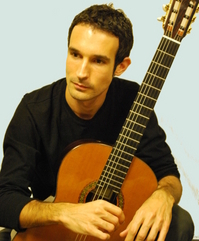Ann Arbor Symphony offers an exciting 'Sabor Latino'

Marco Sartor publicity photo
That was one of the take-aways from the Ann Arbor Symphony Orchestra’s Saturday mainstage concert at the Michigan Theater, where a traversal of music with Latin flair included Rodrigo’s “Fantasia para un Gentilhombre” and Ravel’s “Bolero.”
How worn are the grooves on any old LPs you happen to have of these works? Both inspire high fidelity among listeners; but hearing them up close and personal—and live—in concert is worth the ticket in a performance such as Saturday’s.
And there were bonuses in this “Sabor Latino” concert as well. For the familiar there was Spain channeled via late-German Romanticism in Richard Strauss’s tone poem “Don Juan;” and the Vivaldi Concerto for Guitar and Orchestra in D Major. For the unfamiliar, there was Mexican composer Jose Pablo Moncayo’s “Huapango,” with its syncopations and sway and hints of mariachis hiding in the band.
Uruguayan guitarist Marco Sartor, a rising star in the guitar world making his Ann Arbor debut, was the soloist in the Vivaldi and the Rodrigo. We made his acquaintance first in the Vivaldi, where he and the orchestra, reduced to a small contingent under Music Director Arie Lipsky for trim and nimble baroque appeal, engaged in lively, nuanced, dynamically charged dialog. The articulation was crisp and elegant. Sartor’s playing was full of color, strongly voiced and beautifully ornamented.
The concerto’s lively outer movements were charming and bubbly, but it was the peaceful central movement that was the most captivating in its stillness and poise. And that, in a way, was also the case in the Rodrigo.
The most soulful moments in a performance that was compelling from start to finish came in the “Espanoleta,” where Sartor exploited the guitar’s lower range, and used vibrato to accentuate its speaking voice; his playing bent the musical line for expressivity, never too much and just enough. And again, the dialog with orchestra was exceptional.
The orchestra itself was very much on its game from the concert’s beginning, rocketing off, under Lipsky’s baton, like a red-hot-lover in pursuit of conquest—ardently right for “Don Juan.” Concertmaster Aaron Berofsky and oboist Timothy Michling excelled in their solos; the brass were splendid. No wonder an audience member could not contain a “Wow!” shortly before the work’s real ending.
In truth, there were a few bridge passages in the Strauss where the ear could wander away, but nothing of the sort held true in the riveting Ravel that closed the program. From the distant opening snare drum tattoo to the very present last notes, this was a performance that made you love every repetition of Ravel’s two melodies. Isn’t it wonderful to hear them again? I kept thinking!
To make us feel that way is not just Ravel’s achievement, but the orchestra’s. Lipsky and the players managed the pacing of the undending crescendo brilliantly; the tempo seemed just about perfect (and even), and within it, the players molded the melodic lines with a sort of flowing, sunny sensuality and increasing hints of jazz. The colors—of flute, clarinet and bassoon and all their wind kin; of trumpets, saxophones, horns and trombones; and of the strings, last to add their voices to the melodies—were distinct and dazzling. It added up to something wild—and utterly under control. And all the more exciting for it.


Comments
Honest Abe
Sun, Nov 4, 2012 : 5:53 p.m.
Thank goodness we're not talking about that awful restaurant, Sabor Latino. I could give my review about their nasty food.